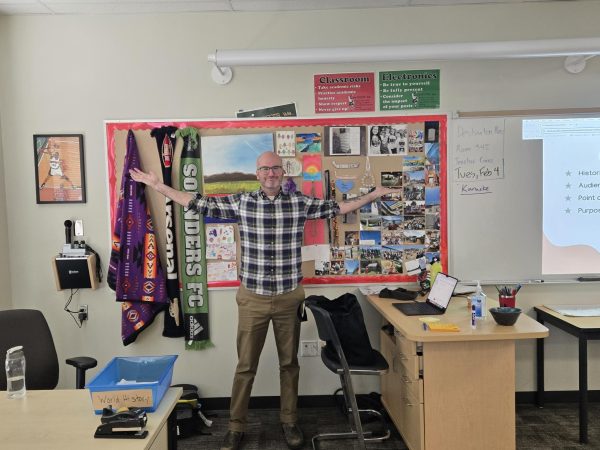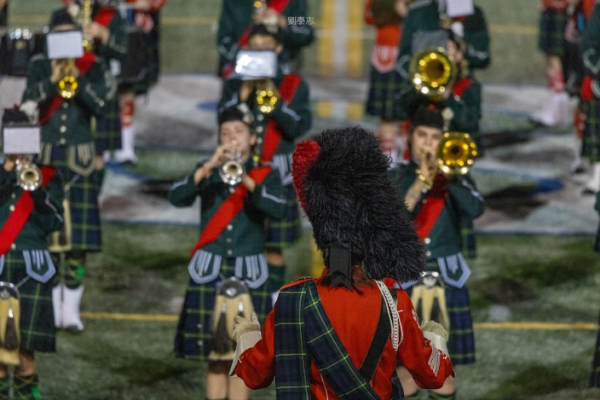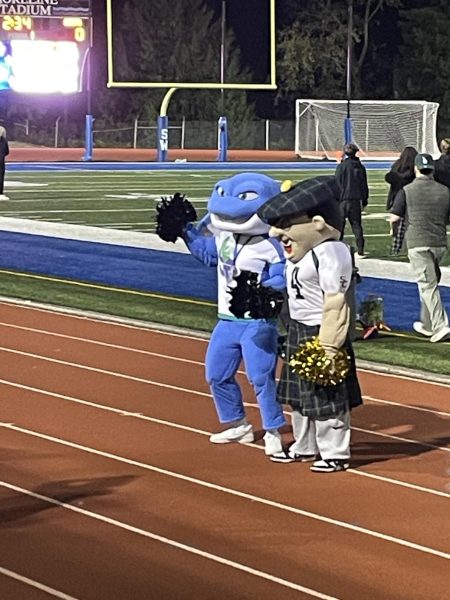Thoughts on Returning to In-Person Learning
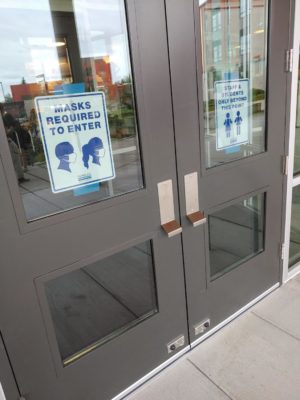
As we start the school year and return to in-person learning, everyone has a lot of mixed emotions on how the school year is going. Even though most people may be overjoyed to finally be returning to in-person school and excited to return to a “normal” learning environment, there are more than a few questions. Are our current COVID policies actually effective? Why do we have to wear masks? And should I get vaccinated?
While many of us assumed that COVID cases would rise as school starts back up, most couldn’t have foreseen exactly how much. From the HealthDay News article: COVID Cases Rise Sharply Among Kids as School Year Starts, “Child cases went from about 38,000 the week ending July 22 to more than 200,000 [from August 22nd to the 28th].” So if the numbers are that high, are the policies that our school has put in place really that effective?
I spoke to a number of students and staff members to see how we as a community are feeling about this important change, and almost everyone I spoke to is in agreement on one thing: We are very happy to be back in person. I think our principal, Lisa Gonzalez, said it best when I spoke to her. “I am delighted that we’re back in person. I have so much emotion around it, so it’s hard to put it into words. To have us all together in the building, having at least some common experience again and being able to have some of our traditions and rituals. Yes, I’m very happy.” The students I spoke to also agreed that overall, being back in person has improved their mental health. Things like seeing friends, joining clubs, and partaking in school spirit have made our school feel like more of a community than just a bunch of blank screens.
One sophomore I spoke to here actually got COVID-19. They had a lot of insight into the policies and if they’re effective. One thing that came up time and time again was the fact that this is a complicated issue and you can’t just answer yes or no. The student told me that before they got COVID, they didn’t have much faith in the school’s policy and process. However, after actually going through that process, their feelings changed drastically. “Well, I used to think that they were not [doing enough]. I was frustrated at their lack of contact tracing. Like, you get the COVID notifications, and they’d say ‘no close contacts.’ And I’d be like, really, you think? But then I actually got COVID, and I hated being stuck at home for a week, and I really understood why they want to make sure that not many people have to do that. And I’m pretty sure that no one else in my classes got it from me, which makes me feel a lot better about [the policy].”
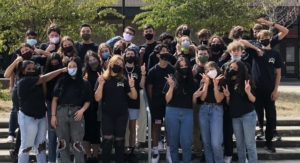
I also asked this student if they felt safe coming to school. They told me that they don’t really know. “Sometimes I feel safe and sometimes I don’t. Today, the person I’m sitting next to in class was coughing all class, and it made me feel super unsafe. But on the other hand, I know I’m vaccinated. I know I do a good job of wearing my mask. I don’t take unnecessary risks, and that makes me feel safer about being back in school.”
When I spoke to our school nurse, Carlene Urrutia, she also had a lot of insightful thoughts about the current policy. “I think I’ve learned through this process that public health, community health, is based on honesty. So I think that it’s not a perfect system, and it can be confusing. And I think unfortunately, sometimes people see how they can get around [the policy]. But at the same time, there’s always going to be outliers. And I think that’s an outlier response. I think most of the responses are wanting to work together, so I can do what I’m supposed to do.” Unfortunately she wasn’t able to share much about the decisions made when forming the policy, as that mostly happened at the state and district level. A lot of our guidelines also came from the CDC, which provided information about how to keep ourselves safe.
One interesting detail that I noticed through conducting these interviews is that there seems to be a lot of dissonance between the staff and students. The faculty and staff I spoke to told me that they think we’re doing a good job of wearing our masks and following COVID protocol. The students, however, were a lot more critical of their peers and told me that they frequently see people wearing masks incorrectly or not social distancing. One student told me, “The circles that I tend to stay in do a pretty good job. Like I’m not one of the people that goes and eats my lunch in the Commons with people who are being unsafe. But every so often I’ll look to see what’s going on there, and I see lots of people being unsafe, but mostly just at lunch, and in extended passing. During classes I’ve seen everyone doing as it tells them to do.” I’m inclined to believe the students, as we are the ones who engage most with our peers and see things that teachers and staff don’t.
Walking around Shorecrest, you might notice that there are many signs enforcing the mask wearing policy, but there are still students who ignore or don’t follow such guidelines. And what might seem like a harmless few seconds can really be impactful. According to the CDC, “People release respiratory fluids during exhalation (e.g., quiet breathing… coughing, sneezing) in the form of droplets across a spectrum of sizes. These droplets carry viruses and transmit infection… The smallest very fine droplets…rapidly dry (and) are small enough that they can remain suspended in the air for minutes to hours.”
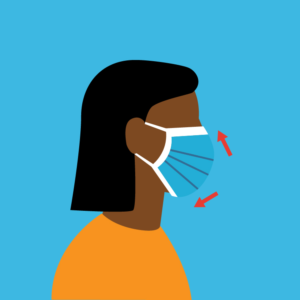
And this risk doesn’t only come from removing your mask. By wearing a mask that doesn’t fit well, or has gaps or holes, the risk of both spreading and catching the virus is much greater than if you wear one approved by the Washington State Department of Health. In their K-12 COVID-19 Requirements for Summer 2021 and the 2021-2022 School Year PDF, a mask is defined as “A cloth face covering is anything that completely covers the mouth and nose and fits securely on the sides of the face and under the chin. It should be made of two or more layers of tightly woven fabric with ties or straps that go around a person’s head or behind their ears.” If these guidelines are not followed, the effectiveness of required mask wearing could decrease significantly.
Some good news is that when COVID is transmitted to children, the severity of the disease is much lower. Still, this means that it could go unrecognized by the student despite being contagious, leading to an outbreak in the school. This could cause us to return to online learning, something I doubt anyone wants to do. I spoke to both Ms. Gonzalez and Ms. Urrutia about the possibility of this happening, and luckily they agreed that the chances are very slim. Ms. Gonzalez said that, “I am going to put money on staying in person because I want to be optimistic and positive. I think if our rates continue to be as slow as they are, we have a darn good shot at it. I will feel more confident with each passing day [as] we get through the flu season.”
According to Ms. Gonzalez, the school policy states that “close contact” is defined as sitting next to or by someone who has tested positive for COVID. However, if you are sitting next to someone else and you’re both wearing masks, then it does not count as “close contact”. As pointed out by the CDC above, wearing a mask doesn’t necessarily prevent the spread of COVID, and that it’s really a mix of both social distancing and mask wearing.
One final thing that would ensure the safety of the students here at Shorecrest even more, would be getting the COVID vaccine. For staff in the Shoreline School district, COVID vaccination is mandatory, but it’s not for the students attending school. However, we know that vaccination against COVID-19 by any of the three FDA approved vaccines is proven to:
1. Strongly decrease your chances of obtaining the virus by helping your body build immunity against COVID.
2. In the event that you may still get COVID, it will lessen the severity of the symptoms.
3. If you get infected with COVID, you’re much less likely to pass the virus on to others around you.
Getting vaccinated is the number one way to protect yourself against COVID, and the most effective step to take if you’re anxious to have everything get back to normal. Even though vaccination of students isn’t mandatory to have them return to schools, it’s heavily recommended by the CDC, local, state, and federal public health officials. All three vaccines have also been tested and approved by the FDA, ensuring their safety.
As a closing note, I want to include one last quote from a student that sums up the intention of this article: “I just want to say that a lot of people are acting like we’re out of this pandemic, and that’s not true. That’s why I got COVID: because people were acting like there wasn’t anything to worry about. And I want to tell whoever is reading the article that we’re not out of the pandemic and people need to keep taking it seriously.”




